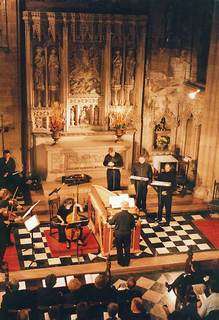|
Back
Of Birth and Rebirth New York
The Cathedral of Saint John the Divine
12/25/2009 -
Religious and Secular Music of the Renaissance by Antoine Busnois, Guillaume Dufay, Richard Pygott, Antoine Brumel, Jacob Clement, Francis Cutting, Daniel Bacheler, Thomas Ravenscroft, Michael Praetorius, Tomas Luis de Victoria, and Joan Ambrosio Dalza, and music from anonymous sources
James Blachly (alto), Eric Brenner (alto), Corey-James Crawford (alto), Todd Frizzell (tenor), Matthew Hensrud (tenor), Scott Mello (tenor), Scott Dispensa (baritone), Thomas McCargar (baritone), Mark Sullivan (bass)
Christopher Morrongiello (lute), Fredrick Renz (Director)

Early Music New York
The Cathedral of Saint John the Divine is one of the treasures of New York City. The building, suffused with light shining through exquisite stained glass windows, is enormous. As proposed in 1872, it was to be the largest church in North America. Albeit of recent vintage, in construction and not just style, it is very much like the real thing. It’s almost all built in stone save for the framework of the roof above the stone vaulting. Instead of the typical flying buttresses found in European cathedrals, architects extended the vaulting of the side aisles upward to support the central nave. One of the main resemblances to medieval cathedrals is probably unintentional; construction has been episodic, interrupted by lack of funds and, in 2001, a massive fire. When it is complete, it will be the largest Gothic cathedral in the world—600 feet long and almost 150 feet wide. There are seven radiating chapels, one of which is dedicated to Saint James and built in the English gothic style. This beautiful jewel of a chapel was the site of the concert. The space is not only magnificent visually but also acoustically. Early Music New York records its CD’s here. One of these, “A Renaissance Christmas,” almost completely duplicates this program.
Early Music New York, now in its thirty-fifth season, was founded by Frederick Renz who, over the years, has served as conductor, producer, director and performer with the group. He has brought his high level of musicological scholarship, in particular his knowledge of the performance practice of early music, to bear on the program. And it showed.
The program was divided into four parts: 15th century France, 15th century Anonymous English Carols, King Henry VIII’s Book, ca. 1515, and 16th century Europe. The fourth section was subdivided into four parts: France/Burgundy; England; Germany; Spain. Given the small size of the group, the variety of vocal color, textures, dynamics and moods was exceptional. As the program unfolded we heard one jewel after another, mostly vocal but also lovely solos for lute played by Christopher Morrongiello.
The first section demonstrated Mr. Renz’s level of expertise. It featured two selections demonstrating the early Renaissance practice of “fauxbourdon” – the adornment of a monophonic tune with improvised harmonizations in three parts. Dufay’s sublime setting of the Advent hymn tune “Conditor alme Siderum” is a contemporary example. In contrast, in the beautifully realized “C’était a l’heure de minuit” with a text that was also used for Easter, it was Mr. Renz who provided the harmonization. The group’s stunning bell-like tone reverberated throughout the chapel.
The second section began with the sprightly and celebratory “Hail Mary full of grace”. Another highlight in this group was “Marvel Not Joseph” in which the performers, singing in unison, fully captured Joseph’s awestruck mood.
The third section featured marvelous contributions, both sprightly and delicate, from Mr. Morrongiello on lute. His performance was so evocative of Henry VIII’s Tudor court that one could almost see the courtiers dancing to the music. The word painting in the carol, “Grene grow’th the holly” was particularly delightful.
The fourth section surveyed sixteenth century Europe in four sub-sections. The first, representing Burgundy and France, began with “Noe, noe” a motet by Antoine Brumel featuring some fine solo contributions by alto Eric Brenner. From England, “Greensleeves” with Mr. Morrongiello’ on lute, was all charm and lilt. Another highlight was the beautiful unison singing of the “Coventry Carol”, a lament sung by the women of Bethlehem just before Herod’s soldiers slaughtered their children. From Germany there were two selections, both by Michael Praetorius. The last section featured music from Spain. Included here was Victoria’s hauntingly beautiful “O magnum mysterium” and a rousing performance of a villancico, “E la don don, verges Maria” with its syncopated dance rhythms.
Arlene Judith Klotzko
|